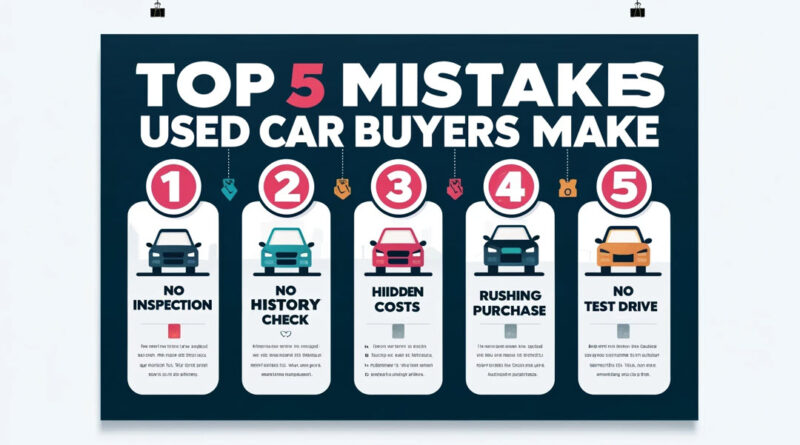Top 5 Mistakes Used Car Buyers Always Make It’s Not Primark
To help you avoid common pitfalls, we’ve put together a list of the top 5 mistakes used car buyers make—and how you can make sure you don’t fall into the same traps. Buying a used car can be a smart financial move—if you do it right. A well-maintained second-hand vehicle can save you thousands compared to buying new, but if you’re not careful, you could end up with a money pit full of hidden issues avoid treating used car market as a Primark. You don’t by new and cheap, you buy second hand and potentially abused goods.
Mistake #1: Not Getting a Pre-Purchase Inspection
One of the biggest mistakes used car buyers make is trusting the seller’s word without verifying the car’s actual condition.
Why This is a Big Mistake
❌ Sellers (especially private sellers or small dealerships) may hide major mechanical issues.
❌ Some cars may look great on the outside but have serious problems under the hood.
❌ A cheap car can quickly become expensive if you end up with costly repairs.
How to Avoid It
✅ Always get a professional pre-purchase inspection before buying.
✅ Use a trusted service like CAREXAMER to have an expert check the car for hidden issues.
✅ If the seller refuses to allow an inspection, walk away—it’s a red flag!
💡 Pro Tip: Spending a little money upfront on an inspection can save you thousands in unexpected repairs later.
Mistake #2: Skipping the Vehicle History Report
Would you buy a house without checking its history? Then why buy a car without knowing its past?
Why This is a Big Mistake
❌ Some used cars have been in serious accidents or written off.
❌ A car might have outstanding finance, meaning it’s technically still owned by a lender.
❌ It could be a stolen vehicle, and you won’t know unless you check.
How to Avoid It
✅ Run a full vehicle history check (services like CarExamer or many more online all car data comes from one source).
✅ Make sure the VIN (Vehicle Identification Number) matches on all documents.
✅ Check for mileage fraud—some sellers roll back odometers to make cars seem newer.
💡 Pro Tip: A few pounds spent on a history report can save you from buying a stolen or dodgy car.
Mistake #3: Not Test Driving the Car
Photos and descriptions don’t tell the whole story—you need to feel how the car drives before making a decision.
Why This is a Big Mistake
❌ Some mechanical problems only show up when driving, like:
- Steering issues (pulling to one side).
- Strange engine noises or vibrations.
- Transmission problems (slipping gears, delayed acceleration).
❌ You won’t know if the car is comfortable or suits your driving style.
How to Avoid It
✅ Test drive the car for at least 15–20 minutes in different conditions (city roads & motorways).
✅ Check the brakes, acceleration, steering, and suspension while driving.
✅ Listen for unusual noises, and make sure the gears shift smoothly.
💡 Pro Tip: If a seller refuses to let you test drive the car, it’s a major red flag—walk away!
Mistake #4: Ignoring Running Costs & Insurance
Just because you can afford to buy a car doesn’t mean you can afford to own it. Many buyers forget to factor in long-term costs.
Why This is a Big Mistake
❌ Some used cars have high maintenance costs (luxury or imported brands).
❌ Older cars with big engines usually drink more fuel.
❌ Some models have higher insurance premiums due to theft risks or expensive repairs.
How to Avoid It
✅ Check insurance costs before you buy (use comparison sites like Confused.com or Compare the Market).
✅ Research fuel economy & road tax costs for the model you’re considering.
✅ Look up common repair costs for the car (some models are notorious for expensive fixes!).
💡 Pro Tip: Owning a reliable, fuel-efficient car saves you more money in the long run than buying something flashy but costly to maintain.
Mistake #5: Rushing Into a Purchase & Not Negotiating
A lot of buyers get emotionally attached to a car and buy it on impulse without doing proper checks and allowing enough time to rethink arrange refundable deposit and give yourself few days to think—or worse, they don’t negotiate the price because they don’t have any facts to negotiate such as pre purchase inspection report.
Why This is a Big Mistake
❌ Rushing leads to bad decisions—you might end up overpaying or buying a car with hidden issues.
❌ Sellers expect negotiation—if you don’t bargain, you might lose out on a better deal.
How to Avoid It
✅ Don’t rush—take your time to compare cars and get multiple options.
✅ Do your research—check how much similar models are selling for.
✅ Negotiate! Sellers usually have some flexibility on price. Even knocking off a few hundred pounds helps!
💡 Pro Tip: Never be afraid to walk away—if a deal doesn’t feel right, there’s always another car out there!
Final Thoughts: Be a Smart Buyer, Not a Regretful One
Buying a used car can be a fantastic way to save money—but only if you avoid these common mistakes.
Quick Recap of What to Do:
✅ Run a full vehicle history check – Don’t risk buying a stolen or written-off car.
✅ Always get a pre-purchase inspection – Hidden problems can cost you thousands.
✅ Test drive the car properly – Make sure it drives smoothly with no issues.
✅ Factor in running costs – Insurance, fuel, and repairs can add up fast.
✅ Negotiate and don’t rush arrange refundable deposit – Smart buyers get the best deals!
Follow these steps, and you’ll drive away with a great car—not a nightmare on wheels! Happy car hunting!
Buying a used VW. Buying used vauxhall, BMW, Jaguar, Ford, Volvo, Range rover, Bentley, Aston Martin, Porsche, Ferrari, Lamborghini, Maserati, Hyundai, Tesla, Honda, Pagani

